
 |

|
|
|
Height: 5'10" Weight: 155 lbs Eyes: hazel Hair: brown Marriages: (1) Carol(yn) Elizabeth Irwin (Feb 2. 1935 - Jul 9. 1941, divorced) (2) Florence Baker, radio actress (Jan 1942 - Sep 26. 1949, divorced) Children: Joyce "Lynn" (1943 - ), Ann (1945 - ). (3) Tina Gray (Apr 30. 1950 - Aug 11. 1953, divorced) (4) Margaret Ann Pexton, fashion historian (Nov 9. 1957 - Sep 25. 1980, divorced) Siblings: Kenneth (1915 - 1991), Alan (1922 - ). |
|
Born in London, United Kingdom as Lionel Breeze (or Breese) on December 6. 1909 *, Murray was the son of a violinist Ethelbert George Walter Breeze and Ida Clough. His father also worked as a blacksmith and teacher. He spent his childhood in the Haymarket, Leicester Square and Hammersmith, where England’s most popular music halls stood. He managed to attend school there pretty regularly. But even these comparatively prosaic days were punctuated with bicycle tours around the British Isle, and with surreptitious painting of mustaches on the busts of Queen Victoria of Julius Caesar. The pranks resulting in periodic lambasting by the headmaster. Although he did receive a few lessons in exchange
for pumping the bellows for a church organist at Barrow-in-Furness
"Breezy" was just the all-boy who laughed like anything when the family
piano fell through the floor into the cellar, thus putting a temporary
stop to the endless pouncing "It wasn't that I didn't like music,"
he explained later, "but that English parlor was like an icebox. You
could have hung a side of beef in there all winter" In 1925 the Murray family journeyed to the United States and settled in Philadelphia. Although Lyn liked the Quaker City, he liked the sea better; and when he was 17, he began a three-week vagabond trip on a freighter. This trip extended to six months. His next trip, on an oil tanker, was short-lived because his mother took him off bodily just before the vessel sailed. So ended this adventure. During that period, as a member of the crew of various vessels, he visited British Trinidad, Cuba and coastwise points between New Orleans and Newfoundland. The Breeze family had settled in Philadelphia and Lionel eventually returned there. At the North East High School in the Quaker City he reported for the Megaphone, the school publication; joined the dramatic and debating clubs. besides giving plenty of time to studying English, history and music and participating in many of the sports activities. Once his general music class at High School had been assigned the task of composing individual original hymns, and the one turned in by the lad now known as Lyn Murray was so excellent that the instructor refused to credit it, insisting that he must have copied it from some source the teacher was unable to trace. Lyn was more flattered than otherwise by this strong skepticism, since he knew the song was all his own. His steadily growing love of music was given a sudden though left-handed boost. He finished his high school course in fundamentals of music. After graduation he worked on several newspapers. He did a stint as a reporter with the Philadelphia Public Ledger. His first steps into a professional career in music, was as assistant organist to the late, great "Fats" Waller at a silent movie house in Philadelphia's Little Harlem. Soon he decided that music was a far more advantageous profession, and he accepted a $15-a-week position as church organist in a small church. He probably inherited his musical talent from his mother, who had some skill as an amateur musician. At 19 Lyn traveled the vaudeville circuits as a pianist playing one-night stands, including a song and dance act at the Guard Theater in the Pennsylvania town. After several weeks as an actor in a stock company he landed in Newport News, Virginia. There he did some radio pioneering in its most fantastic form. A hotel housed the radio studio WGH. When real money wasn't available Murray and his partners discovered that they could ask the hotel manager to sing a solo on the air and all would be forgiven. Lynn acquired a lifetime allergy to the song Macushla, the only number in the manager's repertoire. Having served a radio apprenticeship in Newport News he moved back to Philadelphia WNAT and a made a name for himself finally arriving in New York. Later going on to lead an orchestra in a Newark, NJ, night club. In the meantime he arranged popular airs, a work which rapidly established him in his profession. He was later called to WCAU to take charge of singers and put on a novelty program, Bill and Ginger (WABC Columbia, May 1932 - 1934). |
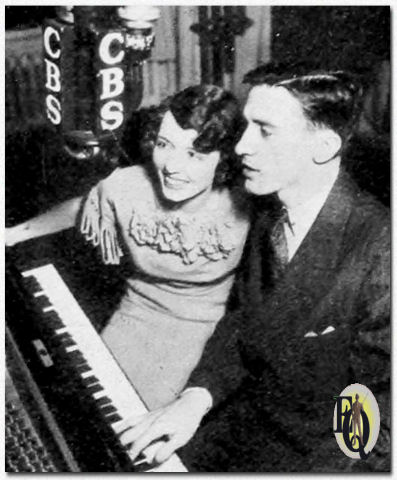 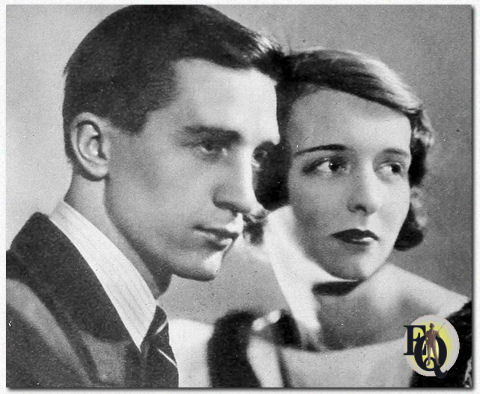 Above: Together, Virginia Baker and Lyn Murray, stars of the Bill and Ginger programs rehearse for a broadcast (Radio Stars, Oct 1933 & Radio Mirror, 1935). |
| In later years, after Lyn had got a toehold in radio, he remembered most gratefully the help he got from Bernard Herrmann and the late Joseph Schillinger. It was composer-conductor Herrmann who first encouraged him to write music for radio and requested that he get the chance to be the first conductor of Columbia's new chamber music orchestra. It was maestro Schillinger who then gave him the only formal lesson in composition he has ever had. (Lyn also attended Juilliard School of Music) |
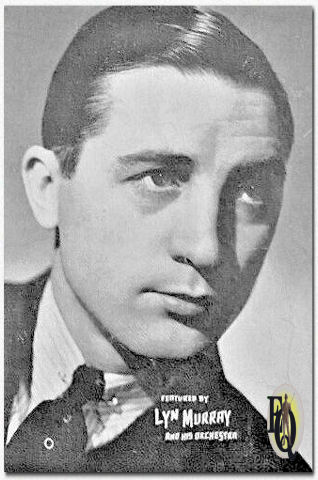  Above: Photos provided for the sheet music of The Umbrella Man (L) and At Least You Could Say Hello (R) |
|
From 1931 to 1937, he was staff conductor and arranger at WCAU in Philadelphia, Pennsylvania. From there, he went to CBS, where he conducted, arranged, and composed music from 1934 to 1947. He married On Carolyn Elizabeth Irwin on February 2. 1935 in Manhattan. At the master CBS station, WABC in New York, he directed orchestras and choral groups. Since the beginning of his radio career, Murray’s work has included coaching vocalists, playing piano for several choral groups, arranging and rehearsing his own trios and quartets, and conducting his own orchestra for some programs of distinction. |
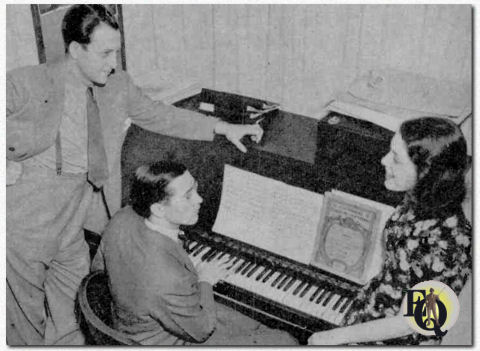 Above: Lyn Murray (at piano), up-and-coming orchestra leader and choral director, rehearses Baritone Barry Wood and Nan Wynn, "Mistress of Song." Wood, Murray and Miss Wynn co-star in CBS' Sunday evening Musical Gazette (Radio Guide, Apr 1938) |
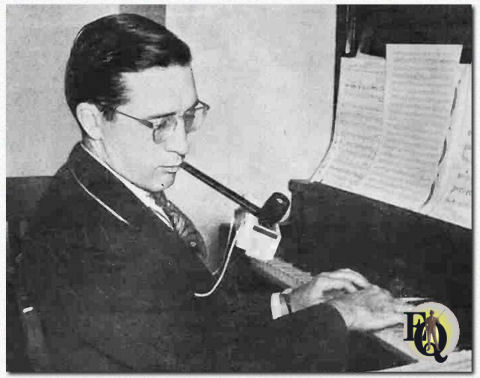 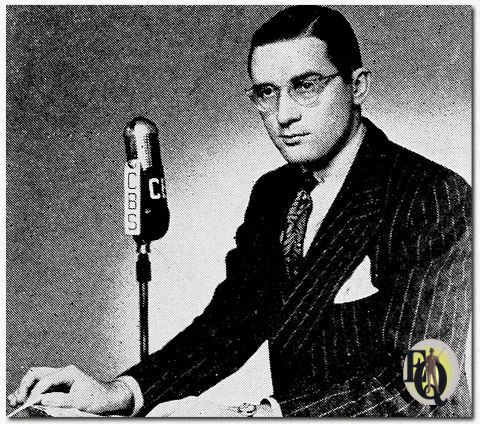 Above left: Lyn Murray likes nothing better than smoking a pipe while he is working on his music. He claims it helps him to relax. Rudy Vallee gave Lyn a pipe with a stem eight inches long and now its the favorite of his collection. Because of its length, the pipe kept turning and spilling ashes over his suit, so one of the boys of the Four Clubmen quartet rigged up a de vice that Murray clamps around his neck and it acts as a rest for the pipe, catches the ashes and holds a pack of matches ... (Radio Guide, Nov 1939) Above right: Lyn Murray Musical Director Ellery Queen. (The Radio Annual, 1940) |
| Arranging choral music for This Is the Army was Murray's first Broadway experience. He went on to do vocal arrangements for Swingin' the Dream (1939), Panama Hattie (1940 - 1942), Let's Face It! (1941 - 1943), and Finian's Rainbow (1947 - 1948; 2009 - 2010). |
|
By July 9. 1941 he was divorced from his first wife and around January 1942 he married Florence Baker, a radio actress, they went on honeymoon to Miami. He officially had his name changed to Lyn Murray in city court, New York in March 1942.
He later founded the Lyn Murray Singers, who became known throughout the
United States as the featured group on CBS Radio's Your Hit Parade. |

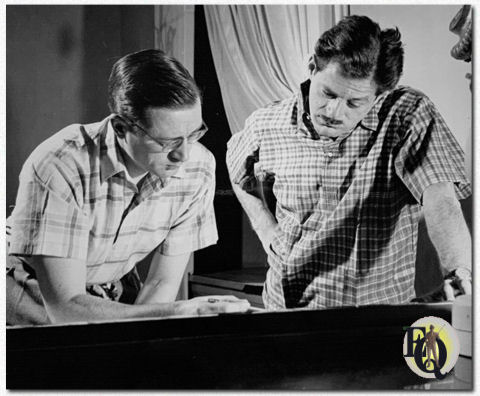 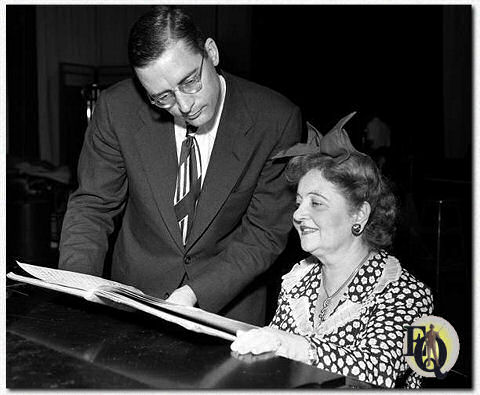 Above left: Lyn Murray (left), composer, conductor and arranger, at work with Norman Corwin on the musical score for Columbia Presents Corwin, the new series starting March 7. 1944 over the CBS network. First broadcast of the series is "Movie Primer". Above right: Lyn Murray Mana Zucca, singer and actress. (Aug 14. 1944. New York). |
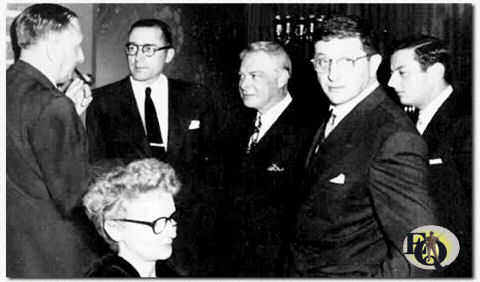 Above: (L-R) William Walton, Lyn Murray, (an unknown man), Bernard Herrmann, Andre Previn, and Helen Deutsch, seated. (Undated, ca. 1946). |
|
Murray worked as a conductor, arranger and producer with
such artists as Bing Crosby, Louis Armstrong and Burl Ives at CBS prior to
moving to NBC in 1947. The Lyn Murray Singers appeared on Broadway in
Finian's Rainbow (1948), singing arrangements written by Murray for the
production. He married a third time this time to Tina Gray on April 30. 1950 and again the marriage ended in divorce on August 11. 1953. His fourth marriage to Margaret Ann Pexton (Nov 9. 1957) had a similar faith on September 25. 1980. As fashion historian Maggie was very successful becoming "Times Woman of the Year" in 1959. |
|
In 1950, Murray moved to Hollywood and provided vocal
arrangements for Walt Disney's 1950 film Cinderella and began composing
scores for feature films, including The Prowler (1951),
To Catch a Thief (1955), D-Day the Sixth of June
(1956), Escape from Zahrain (1962),
Come Fly
with Me (1963), Wives and Lovers
(1963), Promise Her Anything (1965),
Rosie! (1967), Strategy of Terror
(1969), The Cockeyed Cowboys of Calico County
(1970) and Love Hate Love (1971), as well as creating episodic underscoring
for television shows such as The Virginian (1962), Daniel Boone
(1964), The
Time Tunnel (1966), Dragnet
(1967), and the unaired pilot for Mr. Terrific.
He composed the incidental music for 35 episodes of The Alfred Hitchcock Hour between 1962 and 1965 and for 46 episodes of Dragnet 1967 between 1967 and 1969. |
|
Murray won an Emmy Award in 1986 for his score to the National Geographic special Miraculous Machines. In the last few years he composed and conducted for the California Artists Radio Theater, a group of former radio performers. Murray, a founder of the Screen Composer’s Guild and board member of the National Academy of Music, also conducted and arranged for several Decca Records stars, among them Bing Crosby and Louis Armstrong. Murray lived for many years in Pacific Palisades, California, and died of cancer at Cedars-Sinai Medical Center in Los Angeles, aged 79, on May 20. 1989. |
|
Notes: * August 13. 1909 is not correct Programs, facts or dates in red still need confirmation. |
|
Click on Uncle Sam if you think you can help out...!
|
|
Other references
Additional video & audio
sources |
|
This profile is a part of
Ellery Queen a website on deduction.
The person above was a composer, organist for an
Ellery Queen radio
series.
Click Uncle Sam if you think you can help
out...! Many of the profiles on this site have been compiled after very careful research of various sources. Please quote and cite ethically! |
|
Page first published February 13. 2025 Version 1.1 - Last updated April 25. 2025 |
 b
a c k
t o L i s t o f S u s p
e c t s
b
a c k
t o L i s t o f S u s p
e c t s
|
|
| Introduction | Floor Plan | Q.B.I. |
List of Suspects | Whodunit? | Q.E.D. | Kill as directed | New | Copyright Copyright © MCMXCIX-MMXXV Ellery Queen, a website on deduction. All rights reserved. |